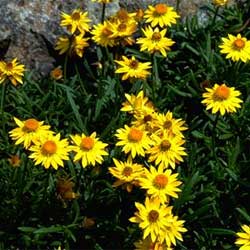Xerochrysum bracteatum 'Diamond Head'
 |
Xerochrysum bracteatum 'Diamond Head' nom. cult.
When this article was written in 1978 this plant was known as Helichrysum bracteatum 'Diamond Head'. Since that time scientific revision of the Australian members of the Asteraceae family (the daisies) has caused many well known Australian plants to be given different names. The current name is shown in the title of this article.
This prostrate form of everlasting daisy or strawflower was found growing naturally at Diamond Head on the mid-north coast of New South Wales and because of its exposed position had developed a stable prostrate habit reducing its overall height, when in flower, to about 16 cm. It is therefore quite distinct from other forms of Xerochrysum bracteatum and as a result was registered as a cultivar by the Australian Cultivar Registration Authority in March 1977 (Registration description).
Xerochrysum bracteatum 'Diamond Head' is a compact perennial herb growing to a height of about 8 cm with a spread of about 45 cm. Leaves are rough, hairy, more or less narrow-oblong, and up to 4 cm long. The height of the plant is doubled to 16 cm when the plant is in flower as the bright yellow flower heads are borne on slender stalks 8 cm above the foliage. Each head consists of a number of florets, the outer ones having papery bracts which are the showy part of the flower. Flower heads are about 3 cm across and are seen from October to May.
Its size and habit are ideally suited for its use in a rockery as an individual plant, or alternatively if plants are placed close together it may be used as a dense ground cover. Either way it does best in a light, well-drained soil in full sun. A new flush of growth is produced when flowering is over in mid-winter. At this time the old season's growth should be pruned back to maintain vigour and a neat appearance.
Although some seed is produced it does not germinate well and a more reliable method of propagation is by means of cuttings. These should be taken when the new tip growth has hardened off slightly in spring. The cuttings should be set in the usual open and well-drained cutting medium .
Xerochrysum bracteatum 'Diamond Head' is rarely affected by winter temperatures. If very young tips are burnt after a severe frost the plants will recover quickly. The only other problem is possible damage by aphis and/or thrip. Consult a qualified horticultural advisor for control of these pests.
Text by ANBG staff (1978)
Name meaning: Xerochrysum bracteatum 'Diamond Head'Xerochrysum - bracteatum - from the Latin, bearing bracts, emphasising the fact that the many bracts of the flowers are colourful and resemble petals Diamond Head - location on the coast of northern New South Wales |
![An Australian Government Initiative [logo]](/images/austgovt_brown_90px.gif)

